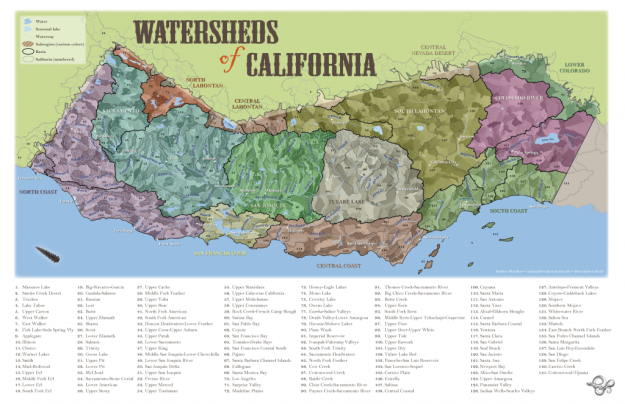Aaron Carapella has compiled all the original (self-identified) names of the American Indians on a map showing the locations of their original homes. It immediately gives a sense of the extent and variety of Indians occupying the continent.
See the full story here: The Map of Native American Tribes You’ve Never Seen Before
Or go straight to the PDF file of the map: Tribal_Nations_Map_of North America
There is a separate map for Mexico you can find in the article.
Ethnoecological hypotheses for high density of Indian tribes and populations in California and the coastal Pacific Northwest:
Like other similar maps produced before (which usually show the names colonists gave to Indians, such as “Costanoan” for SF Bay Area Indians, which just means inhabiting the coast), another remarkable feature is the high diversity of tribes in California, as well as the Pacific Coast. I’d attribute this high diversity, which goes along with notably large original populations (Heizer and Elsasser 1980), to the high diversity and productivity of ecosystems in these regions.
The unit of land-ownership for the American Indians was a watershed (Heizer and Elsasser 1980). Indian tribes would own both sides of a creek or river, and the mountains behind them with their tributaries, ending at the ridgetops that began another tribe’s territory (Heizer and Elsasser 1980). The wrinkled topography, caused by the geologic uplift from the subduction of the Pacific plate along the coast, has led to many distinct watersheds concentrated in a small area in California and the Pacific Northwest coast.
Thus the high density of tribes may be simply a result of the division of tribal groups by the high density of watersheds. If one looks at a map of the watersheds, the tribes do seem to be at least partly corresponding to different watersheds. If the names map had higher resolution, reflecting how each of these tribes divided into smaller groups and tribelets, this hypothesis would probably be better supported.
Interestingly, larger tribe groups tend to mirror the hierarchical structure of the watersheds, claiming large watersheds (different colors in the below map), and their constituent tribes claiming smaller watersheds within (different shades of one color in the below map).
Another, related reason for the high density of tribal names and population size is the ecology of the area. The massive trees of the coastal Pacific Northwest, along with their lush understories, forming specialized assemblages in every nook and cranny of the convoluted topography, gives rise to ecosystems with a huge variety and abundance of plant and animal life, next to ecosystems that are entirely different yet close-by. The Indians of the Pacific Northwest, relying upon these profuse plants and animals, therefore did not have to harvest from a large area of land to meet their needs, but could live in peace with close neighbors and at high population densities without risk of hunger.
Supporting this latter hypothesis is the recent synthetic finding of Ethnobotanists is that regions of high biological diversity strongly correlate with regions of highest linguistic and cultural diversity (Carlson and Maffi 2004, Nolan and Turner 2011).
A final alternative hypothesis is simply that by the time ethnographies were conducted to record all the names of the tribes, the areas with fewer tribal names had already been decimated, leaving few behind to have their names recorded. Although California and the west coast was indeed some of the last territory to be settled and the Indians rounded up and exterminated, this hypothesis is refutable by comparing to the east coast.
The eastern coast, the first areas to be settled and the Indians persecuted, has a similarly high density of tribal names, though somewhat more dispersed or clumped. Note also Florida and along the southeast coast there is a rather high density of tribes, and that these areas have remarkably high diversity of plant life, though are not very mountainous. These patterns, along with the general tendency for high tribal name density on the map to correlate well with mountainous areas and/or areas of high plant diversity, lends support to the watershed and/or ecological diversity hypotheses I gave above.
Further support of these hypotheses can be seen in the areas of low density of tribal names. The mountainous eastern Rockies, though dense with watersheds, have very little water. These deserts and dry forests have low plant diversity, and accordingly seem to support few tribes, at presumably low population densities. Furthermore, the midwest, the belt from Canada to Texas about two states wide, consists of flat grasslands; areas with low density of watersheds and little environmental heterogeneity. Despite its high soil fertility and productivity of grazing animals, predictably, this area also has low density of tribal names, and presumably, Indian populations. Similarly, in the far north, where boreal forest, tundra, or arctic ecosystems predominate, there is a low density of tribal names, and presumably populations, since these ecosystems are very homogenous, with low plant diversity and low productivity of plant energy.
To put it (somewhat) simply, humans are animals too, and just as how animal diversity (at the levels of genotypes, populations, and species) is directly positively related to plant diversity and environmental heterogeneity, so is the diversity of Homo sapiens (here presumably at the genotypic, and population / cultural levels) directly positively related to plant diversity and environmental heterogeneity (namely density of watersheds).
REFERENCES
Carlson, T. and L. Maffi (eds.). 2004. Ethnobotany and conservation of biocultural diversity. Advances in economic botany Vol. 15. Botanical Garden Press, New York, NY.
Heizer, Robert F. and Albert B. Elsasser. 1980. The natural world of the California Indians. University of California Press, Berkeley, CA.
Nolan, J. M. and N. J. Turner. Ethnobotany: the study of people-plant relationships. In Anderson, E. N., D. M. Pearsall, E. S. Hunn, and N. J. Turner (eds.). 2011. Ethnobiology. Wiley-Blackwell, Hoboken, NJ.


